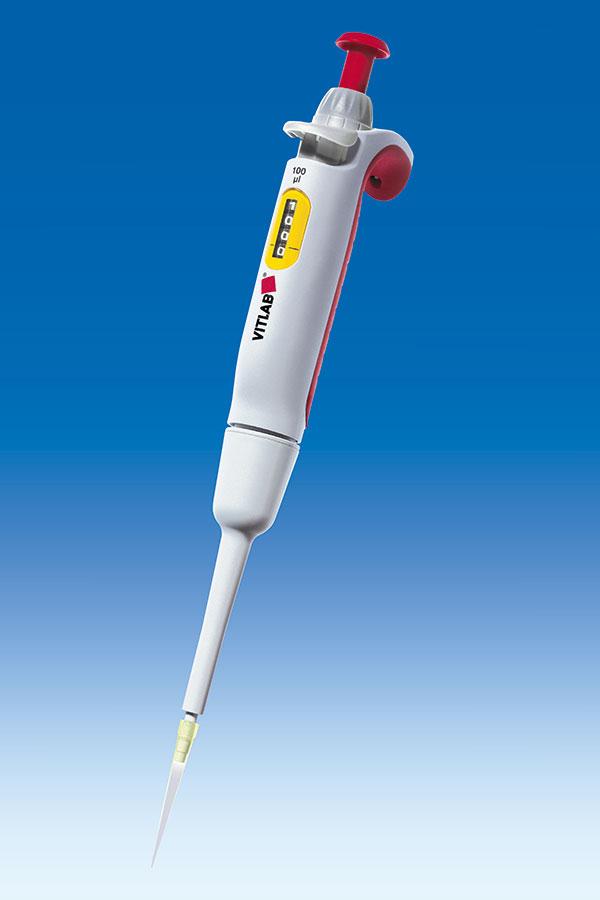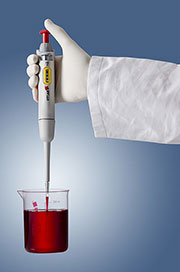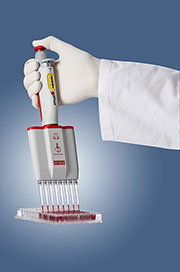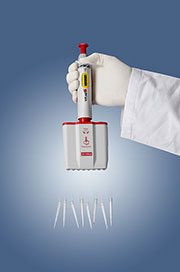
Vitlab Micropipette
VITLAB Micropipette is characterized by their especially user-friendly operation while pipetting long series and is suitable for beginners as well as advanced users.
Product Description
The VITLAB® piston-operated pipettes are the ideal manual pipettes for demanding laboratory applications, and have all the features required by users: robust, with ergonomic shape and simple operation, completely autoclavable, highly accurate with simple calibration for long-lasting reliability.
The large, central pipetting button provides a uniform and smooth movement of the piston. For rapid replacement of the tips, the ergonomic eject button is placed easily accessible to the thumb on the front side. The VITLAB® micropipette is easy to use for both right and left-handers.
The 4-digit volume display with integrated zoom function and vertical arrangement of the numbers (top to bottom reading direction) ensures an optimal readability of the volume at all times. The desired volume can be set by rotating the volumesetting wheel with ease and precision. The clearly visible colour-coded frame of the volume display allows easy selection of the right pipette tip.
If necessary, e.g. for applications with non-aqueous solutions, the integrated calibration function allows an adjustment without tools directly in the laboratory. The corrosion- resistant piston and ejector ensure a long product life.
The micropipette is completely autoclavable at 121 °C (2 bar) according to DIN EN 285. Also available with DAkkS calibration certificate.
Efficiency in variable pipetting
Aspirate sample

- Adjust volume
- Use the correct tip(s) according to the volume range (Color-Code)
- Press the pipetting button to the first stop and keep the button pressed
- Immerse the pipette tip(s) 2 to 6 mm into the liquid (depending on volume)
- Let the pipetting button slide back slowly while holding the pipette in an upright position (the liquid will be aspirated)
Pipetting sample

- Place the pipette tip(s) against the wall of the receiving vessel
- Press the pipetting button slowly and evenly down to the second stop (over-stroke) to empty the tip(s) completely
- Ensure while discharging the sample that the tip(s) are not immersed into the liquid that might be in the receiving vessel
- Wipe the pipette tip(s) against the receiving vessel wall over a distance of approx. 10 mm
Ejecting the tip(s)

- Keep the pipetting button pressed while removing the pipette from the receiving vessel
- Let the pipetting button slide back slowly
- Press the tip ejection key to remove the tip(s)
- Correctly dispose of pipette tip(s)
- Store the pipette in an upright position when not in use (VITLAB bench top rack/ shelf mount)
Optimal pipetting
For exact and precise analytical results, the following points should be considered, independent of the pipetting technique:
- The best results are obtained with pipette tips that are recommended by the manufacturer, since only they have been checked for an optimal fit with the pipette.
- A second important factor that can influence the analytical result is the quality of the tip material. VITLAB® pipette tips are manufactured from high quality polypropylene.
- Pipette tips are intended for single-use only. Reuse and cleaning of used pipette tips should be avoided because it can influence accuracy and lead to cross-contamination of samples.
- The pipette should be held vertically while aspirating the sample because an increase in the angle of inclination can result in volume errors.
- To obtain optimal results, the immersion depth of the tip should only be a few millimetres (depending on volume).
- The air-interface between piston and sample should be kept as small as possible. The smaller the air-interface the higher is the accuracy of the result. The color-code helps with the selection of the fitting pipette tip.
Forward pipetting

Reverse pipetting

The reverse pipetting technique should be used to pipet viscous solutions, wetting solvents or media with high vapour pressure with air-interface pipettes. In contrast to forward pipetting, the reverse pipetting technique is as follows:
Types / Sizes
0,5 – 10 (Volume ml)
| A ≤ ± % | 1,0 |
|---|---|
| Accuracy ≤ ± µl | 0,1 |
| CV ≤ % | 0,5 |
| Coefficient of variation ≤ µl | 0,05 |
| Tip μl | 20 |
| PU | 1 |
| Cat. No. | 1641000 |
2 – 20 (Volume ml)
| A ≤ ± % | 0,8 |
|---|---|
| Accuracy ≤ ± µl | 0,16 |
| CV ≤ % | 0,4 |
| Coefficient of variation ≤ µl | 0,08 |
| Tip μl | 200 |
| PU | 1 |
| Cat. No. | 1641002 |
10 – 100 (Volume ml)
| A ≤ ± % | 0,6 |
|---|---|
| Accuracy ≤ ± µl | 0,6 |
| CV ≤ % | 0,2 |
| Coefficient of variation ≤ µl | 0,2 |
| Tip μl | 200/300 |
| PU | 1 |
| Cat. No. | 1641004 |
20 – 200 (Volume ml)
| A ≤ ± % | 0,6 |
|---|---|
| Accuracy ≤ ± µl | 1,2 |
| CV ≤ % | 0,2 |
| Coefficient of variation ≤ µl | 0,4 |
| Tip μl | 200/300 |
| PU | 1 |
| Cat. No. | 1641006 |
100 – 1000 (Volume ml)
| A ≤ ± % | 0,6 |
|---|---|
| Accuracy ≤ ± µl | 6 |
| CV ≤ % | 0,2 |
| Coefficient of variation ≤ µl | 2 |
| Tip μl | 1000 |
| PU | 1 |
| Cat. No. | 1641008 |
500 – 5000 (Volume ml)
| A ≤ ± % | 0,6 |
|---|---|
| Accuracy ≤ ± µl | 30 |
| CV ≤ % | 0,2 |
| Coefficient of variation ≤ µl | 10 |
| Tip μl | 5000 |
| PU | 1 |
| Cat. No. | 1641010 |
1000 – 10000 (Volume ml)
| A ≤ ± % | 0,6 |
|---|---|
| Accuracy ≤ ± µl | 60 |
| CV ≤ % | 0,2 |
| Coefficient of variation ≤ µl | 20 |
| Tip μl | 10000 |
| PU | 1 |
| Cat. No. | 1641012 |
